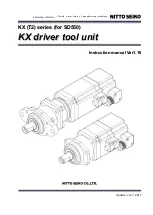
5.5 Control terminals
BU 0500 GB
Subject to technical alterations
91
Parameter
Set value / Description / Note
Device
Supervisor
Parameter
set
P418
Analog output function
P
0 ... 52
[ 0 ]
Analog functions
(max. load: 5mA analog, 20mA digital)
:
An analog voltage (0 ... +10 Volt) can be taken from the control terminals (max. 5mA). Various
functions are available, whereby:
0 Volt analog voltage always corresponds to 0% of the selected value.
10 V always corresponds to the motor nominal values (unless otherwise stated) multiplied by the
P419 standardisation factor, e.g.:
⇒
100%
P419
value
nominal
motor
10Volt
⋅
=
0 = No function,
no output signal at the terminals.
1 = Actual frequency,
the analog voltage is proportional to the FI output frequency.
2 = Actual speed,
this is the synchronous speed calculated by the FI based on the existing
setpoint. Load-dependent speed fluctuations are not taken into account.
If Servo mode is being used, the measured speed will be output via this function.
3 = Current
, the effective value of the output current supplied by the FI.
4 = Torque current,
displays the motor load torque calculated by the FI. (100% = P112)
5 = Voltage
, the output voltage supplied by the FI.
6 = Link voltage,
the DC voltage in the FI. This is not based on the nominal motor data. 10V
Volt, standardised at 100%, is equivalent to 450V DC (230V mains) or 850 Volt DC (480V
mains)!
7 = Value from P542,
the analog output can be set using parameter P542 independently of
the actual operating status of the FI For example, with Bus switching (parameter
command) this function can supply an analog value from the FI, which is triggered by the
control unit.
8 = Apparent power:
the actual apparent power calculated by the FI.
9 = Effective power:
the actual effective power calculated by the FI.
10 = Torque [%]:
the current torque calculated by the FI.
11 = Field [%]:
the current field in the motor calculated by the FI.
12 = Output frequency ±,
the analog voltage is proportional to the output frequency of the FI,
whereby the zero point is shifted to 5V. For rotation to the right, values between 5V and
10V are output, and for rotation to the left values between 5V and 0V.
13 = Motor rotation speed ±,
is the synchronic rotation speed calculated by the FI, based on
the current setpoint, where the null point has been shifted to 5V. For rotation to the right,
values between 5V and 10V are output, and for rotation to the left values between 5V
and 0V.
If Servo mode is being used, the measured speed will be output via this function.
14 = Torque [%] ±,
is the actual torque calculated by the FI, whereby the zero point is shifted
to 5V. For drive torques, values between 5V and 10V are output, and for generator
torque, values between 5V and 0V.
30 = Setpoint frequency before frequency ramp,
displays the frequency produced by any
upstream controllers (ISD, PID, etc.). This is then the setpoint frequency for the power
stage after it has been adjusted by the acceleration or braking ramp (P102, P103).
31 = Value via BUS,
the analog output is controlled via a bus system. The process data is
directly transferred (P546, P547, P548).
33 = Frequency from setpoint source,
“Frequency from setpoint source” (SW 1.6 and
above)
... continued on the next page
















































